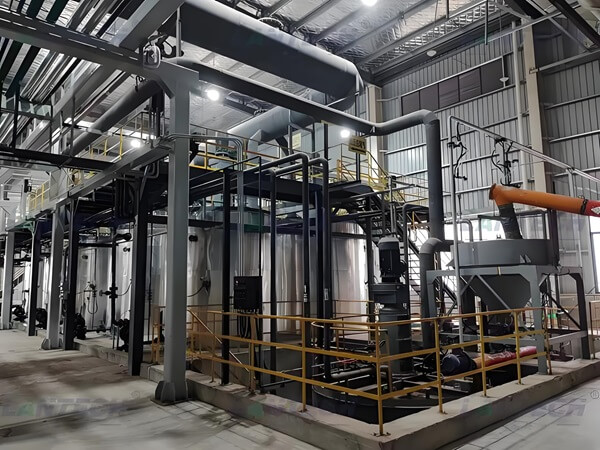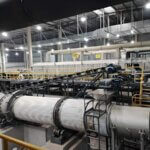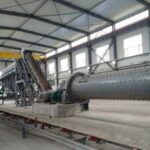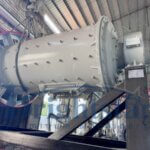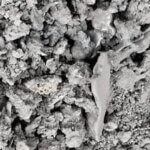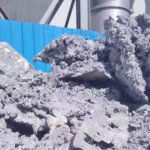All you need to know about wet process harmless treatment of secondary aluminum dross
All you need to know about wet process harmless treatment of secondary aluminum dross
Why is secondary aluminum dross listed as hazardous waste?
After aluminum dross was listed as hazardous waste, secondary aluminum dross(SAD) was listed in the “National List of Hazardous Wastes” in 2019.
The reason why secondary aluminum dross is listed in the list of hazardous wastes is that SAD has obvious reactivity and chemical toxicity.
We know that secondary aluminum dross usually contains aluminum nitride, metallic aluminum, aluminum carbide and fluoride, etc.
The aluminum nitride, metallic aluminum and aluminum carbide contained in it will undergo hydrolysis reaction when they come into contact with water or humid gas, generating aluminum hydroxide, ammonia, hydrogen and methane respectively.
The production of ammonia will pollute the atmosphere and the water and soil in the storage area.
Hydrogen and methane are flammable and explosive gases, and their production and emission will pose a major safety hazard.
The fluoride contained is a toxic and harmful substance, and its decomposition and release will also pollute the water and soil, and seriously endanger the safety of residents and livestock in the storage area and surrounding areas.
In view of these factors, secondary aluminum dross is listed as hazardous waste.
What are the methods for harmless treatment of secondary aluminum dross?
There are two methods for the harmless disposal of secondary aluminum dross: wet method and dry method.
The wet method is the hydrolysis method, which is also known as the water washing method.
This method is based on the physical properties of aluminum nitride, metallic aluminum, and aluminum carbide in aluminum dross that easily react with water to generate aluminum hydroxide, ammonia, hydrogen, and methane.
The conversion of harmful substances in aluminum dross is achieved through hydrolysis reaction.
The conversion process volatilizes ammonia, hydrogen, and methane gases and collects and disposes of them.
At the same time, the soluble fluorides in the secondary aluminum dross are solidified, thereby completing the conversion of aluminum dross from hazardous waste to general industrial waste and achieving harmless disposal of secondary aluminum dross.
The dry method is a heat treatment method, that is, a calcination method.
This method is based on the principle that aluminum nitride in secondary aluminum dross can be converted into aluminum oxide and nitrogen by roasting under high temperature and oxygen conditions.
The aluminum nitride, metallic aluminum, and aluminum carbide contained in the aluminum dross are converted into aluminum oxide, nitrogen, and carbon dioxide by roasting.
The treatment process simultaneously realizes the solidification of fluoride, thereby realizing the harmless disposal of secondary aluminum dross.
What are the limitations of the hydrolysis method for aluminum dross disposal?
The hydrolysis method is a commonly used method for harmless disposal of aluminum dross, but people often think it is relatively simple, thinking that it can be washed with water.
They do not know that the hydrolysis method for treating secondary aluminum dross is conditional.
At the same time, there are still problems such as incomplete decomposition of aluminum nitride, the need to optimize the ammonia recovery plan, and the existence of ammonia, hydrogen, and methane gas explosion safety hazards in the hydrolysis process.
In particular, the problem of incomplete decomposition of aluminum nitride is mainly due to the fact that the hydrolysis process of aluminum nitride can easily form hydrated aluminum oxide on the surface of the particles, blocking further contact between water and aluminum nitride, and limiting the hydrolysis reaction between aluminum nitride and water, ultimately resulting in the denitrification rate being limited to below 70%, and even lower than 50%, making it difficult for the aluminum dross to meet the standards after disposal.
At the same time, the ammonia decomposed from aluminum nitride in the disposal process has a high solubility in water.
How to more effectively separate ammonia from the slurry system is a problem worth considering.
In addition, whether to recover the volatilized ammonia as ammonia water or ammonium salt, and how to avoid the impact of incomplete ammonia recovery or secondary volatilization of ammonia water on the environment are also issues worth noting.
What are the methods for treating ammonia in aluminum dross by hydrolysis? What are the pros and cons of each?
Hydrogen and methane produced in the aluminum dross treatment process are both flammable and explosive gases.
Doing a good job in preventing and controlling combustion and explosion accidents during the treatment process and ensuring safe production are the prerequisites for harmless disposal of aluminum dross.
The disposal methods of ammonia produced by aluminum hydrolysis are to recover ammonia water and ammonium salt.
The advantage of recovering ammonia water is that the process is relatively simple and the equipment investment is relatively small, but the disadvantage is that the ammonia recovery rate is low and the concentration of ammonia water is low, between 1.5 and 7.5%.
At the same time, the volatility of ammonia water makes it difficult to meet the ammonia nitrogen concentration in the tail gas.
The ammonium salt recovery process usually refers to the recovery of ammonium sulfate, which has the advantage that the tail gas from the disposal process can meet the emission standards and does not pollute the environment.
In the general process, the ammonium sulfate recovery process requires evaporation and concentration of the collected ammonium sulfate solution, which has a high operating cost.
However, the improved ammonium sulfate recovery process from ammonia can directly produce ammonium sulfate crystals without evaporating the ammonium sulfate solution, and has a good application prospect.
What is the commonly used equipment for disposing of aluminum dross by hydrolysis process?
When the goal is to recover ammonium sulfate, the commonly used equipment includes hydrolysis reactor, direct crystallization ammonium sulfate recovery system, filter press, chloride salt evaporation crystallization system, high temperature chloride salt crystallizer, low temperature chloride salt crystallizer, centrifuge, etc.
When the goal is to recover ammonia water (recovering ammonia water with a concentration of 20%), the commonly used equipment includes hydrolysis reactor, reducer, full condenser, gas washing and negative pressure system, filter press, chloride salt evaporation crystallization system, high temperature chloride salt crystallizer, low temperature chloride salt crystallizer, centrifuge, etc.
Can the hydrolysis method be used to recover combustible gases from aluminum dross?
Theoretically, the hydrogen and methane produced by the hydrolysis of metallic aluminum and aluminum carbide in aluminum dross can be recovered, but since the content of metallic aluminum and aluminum carbide in secondary aluminum dross is low and fluctuates greatly, it has no recovery value.
From the domestic situation, the recovery of combustibility in the aluminum dross disposal process is only a concept, and no relevant experiments have been conducted.
What products can be produced with secondary aluminum dross?
Secondary aluminum dross can be used to produce pre-melted calcium aluminate for steelmaking, calcium aluminate for water treatment, hydrated calcium aluminate, polyaluminum chloride, oil fracturing proppants, clear bricks, and high-value-added dry aluminum fluoride, cryolite, and aluminum hydroxide for flame retardancy.
Among them, the production of calcium aluminate, polyaluminum chloride, Ceramic proppant, etc. has a relatively low technical threshold, simple process, and low equipment investment.
Are there any safety hazards in the harmless disposal process of secondary aluminum dross?
Yes, there are safety hazards.
The safety hazards mainly refer to ammonia and combustible gases produced during the hydrolysis of aluminum nitride, metallic aluminum, and aluminum carbide.
The explosion limit of ammonia is 15.5%~27.7%, the explosion limit of hydrogen is 4.0%~75.6%, and the explosion limit of methane is 5%~15%.
How to recycle the chloride produced in the harmless disposal process of aluminum dross?
The chlorides contained in secondary aluminum dross are potassium chloride and sodium chloride.
The current domestic recycling process is to recycle mixed salt, that is, a mixture of sodium chloride and potassium chloride.
This mixture can neither be used as industrial salt nor as agricultural fertilizer, so it has no commercial value.
The improved secondary aluminum dross harmless disposal process separates sodium chloride and potassium chloride by taking technical and equipment measures, and the resulting product meets the industrial salt standard and agricultural potassium chloride standard.
Brightstar Aluminum Machinery offers the dry process and wet process harmless treatment for secondary aluminum dross, Turnkey project and package deal!
Contact us now to get the solution for secondary aluminum dross processing.

